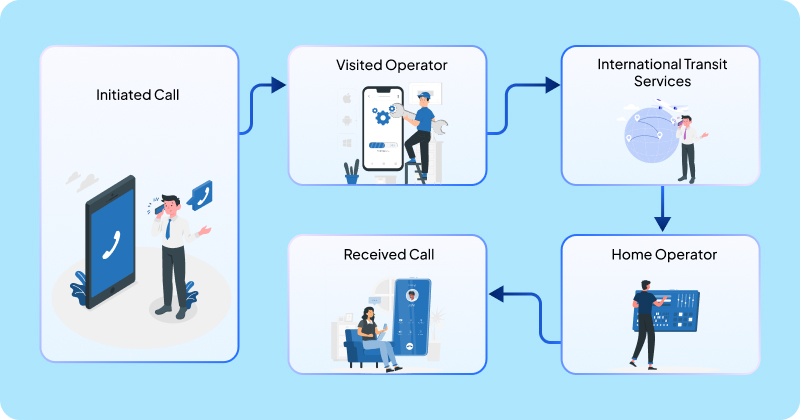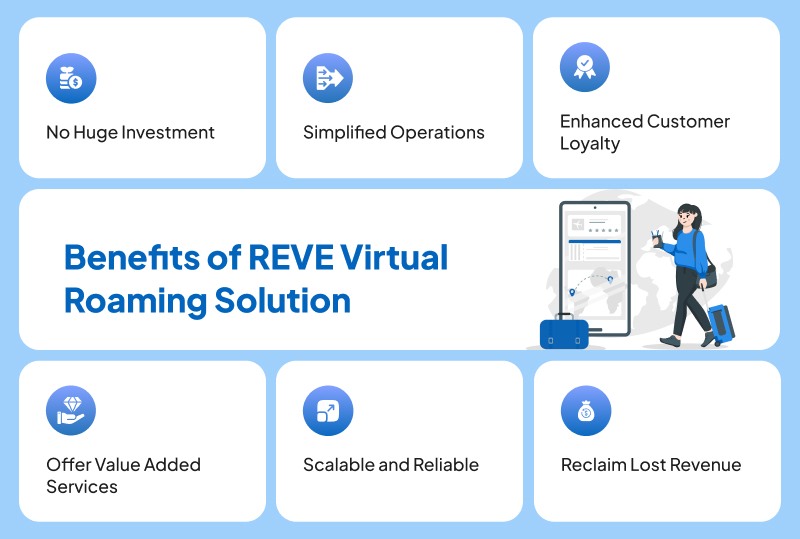
With every international trip comes international roaming because it is one of those essentials for staying connected when traveling overseas. Isn’t it amazing that with just a smartphone in hand, travelers can stay connected to their circle regardless of the location? International roaming helps mobile devices transition seamlessly from the home to the destination networks. While the service is invaluable, it comes with a host of complexities for MNOs, MVNOs, and service providers. This blog delves deep into how does international roaming work, its challenges, and how virtual roaming solutions are a boon for the telcos.
What is International Roaming? The Concept
When someone travels internationally, they first want to remain contactable on their existing mobile number. International roaming enables mobile phone users to access voice, text, and data services when they travel outside their home location’s network area.
If we refer to the definition of roaming as per Wikipedia, then we can conclude it as:
Roaming means that when a mobile user travels outside their home network’s coverage area i.e. when they connect to a ‘visiting network’, they can still make calls, send messages, use the internet, and access other services which they were using in their home network.

In other words, we can say that international roaming is the technology that maintains seamless connectivity between the user’s home network and a foreign network, also called the host network or the visited network.
The next thing that comes to mind is: who is behind the process of international roaming? Well, your mobile network operators are the ones who provide you with international roaming services. Now imagine, what will happen if your mobile service provider does not offer international roaming?
As you travel across the borders, you’ll experience several challenges in connectivity, including:
- Not able to make and receive calls, access SMS, and mobile data services.
- You’ll have limited communication options: either you have to get a local SIM card or rely solely on Wi-Fi
- Missed calls from friends, family, colleagues, and clients
- Delay in response due to dependency on alternate solutions
How Domestic/National Roaming and International Roaming are Different?
To understand the added challenges of international roaming, we should first understand domestic roaming. Domestic roaming is a service that allows mobile users to access mobile phone services outside their home network but within their home country. Domestic roaming services operate within the boundaries of the home country. These services are often available at lower costs.
On the other side, international roaming is a service that allows users to access mobile phone services outside their home country network i.e. when they travel across borders. International roaming operates across different regions or countries. The costs for these services are usually high due to international carrier agreements and cross-border infrastructure use.
The primary goal of both types of roaming services is the same, i.e. to enable seamless connectivity. However, they differ significantly in terms of coverage, costs, and operational complexity. Let’s take a look at the table below that highlights the key differences between them for better understanding.
|
Feature |
National Roaming |
International Roaming |
|
Definition |
Using your mobile phone on a network other than your home network within your home country. | Using your mobile phone on a network in a foreign country. |
|
Coverage Area |
Within your home country, but outside your home network’s coverage area. |
In a foreign country. |
|
Network Used |
Partner networks within your home country. |
Partner networks in the foreign country. |
|
Charges |
Typically lower than international roaming charges, but may still incur additional fees. |
Generally higher charges due to international agreements between network providers. |
|
Data Usage |
May be subject to data caps and overage charges. |
Often subject to high data roaming charges. Consider purchasing a local SIM card or using Wi-Fi for data. |
|
Activation |
Usually automatically activated when you move outside your home network’s coverage area. |
May require activation through your home network provider. |
How Does International Roaming Work?
Here’s a detailed explanation of key steps in the international roaming process:

- Device Detection and Network Selection
As soon as you land in a foreign country and turn on your mobile device, the device automatically searches for the available mobile networks, and a signal is sent to the nearest compatible network by your device.
- Authentication
The foreign network then checks your SIM card details and verifies your subscription with your home network provider. The home network operator authenticates your identity and authorize the use of their services.
- Service Provision
Once authenticated, the foreign network provides you with the services you request. This includes incoming and outgoing calls, SMS, and internet usage. All of the services you use during this period are reported back to your home operator by the foreign network for billing.
- Billing and Charges
Foreign networks charge your home network for the services you use. Your home network adds a markup and bills you accordingly.
Major Challenges in International Roaming
Did you know that “10-20% of travelers do not connect to mobile networks at all when abroad. This is often due to high roaming charges or unreliable connectivity.” Source – OpenSignal
It is quite clear that an international traveler needs roaming service on their mobile phone so that they are not stuck when outside their home country. However, it is important to note that international roaming comes with its own set of challenges, both for users and operators. Let’s discuss them, one by one:
Challenges For Mobile Users

1. High Roaming Charges
International roaming facility provided by your service provider offers you the convenience of staying connected, no matter where you are. However, this convenience comes at a cost. The charges for international roaming are significantly higher compared to domestic service charges. This often causes bill shock or burns a big hole in the pocket of the travelers.
Let’s take a look at international roaming charges for different mobile services:
- Incoming and Outgoing Calling
Let’s consider the example of AT&T, one of the major carriers worldwide. According to FCC, AT&T’s basic international calling rates include $5 for calls to China, $5 for calls to India, $3.65 for calls to Mexico, and $3.70 for calls to the UK. So even if you are on a 5-minute call with someone internationally, it will be $25 for one call. And, having 10 such calls throughout your trip can make you pay $2500, which is a good amount of money.
- Sending and Receiving SMS
Likewise for texting internationally, users are often charged as good as 50 cents or half a dollar. So if you exchange 50 SMS messages during your entire trip, you end up paying 2500 cents for the messages alone.
- Using Mobile Data for Internet Browsing
Mobile data rates often range between $5 to $10 per MB of data. So during an international trip, watching a 5-minute video can cost the user anywhere between $50 to $125.
2. Network Congestion
Mobile users may experience dropped quality of service due to network congestion. This happens especially in tourist destinations and during peak travel seasons.
3. Security Risks
Using your mobile phone service by connecting to a foreign network when traveling exposes your device to potential security threats. Hacking attempts and data breaches can happen if the operator has not implemented robust security measures to protect subscriber data.
Challenges for Operators
Operators also face various unique challenges as they provide seamless international roaming services. Have a look:
1. High Operational Costs
Operators maintain contracts with host networks. Negotiations for fair prices are often difficult, especially in areas with high demand and limited competition. This means they have to share their revenue and receive reduced profit margins. Additionally, setting up and maintaining the technical infrastructure required for international roaming, including connections, is costly.
2. Complex Partnership Management
Telcos need to establish agreements with not just one but multiple international operators, which in itself is a time-consuming and resource-intensive process. Furthermore, navigating and complying with different regulatory requirements including pricing, taxation, and data privacy across different countries around the world presents an additional complexity for operators while establishing roaming agreements.
3. Limited Coverage
Operators need to ensure seamless roaming across different network technologies including 2G, 3G, 4G, and 5G, which is a technically demanding job. The inability to adapt to newer and older network technologies may result in limited coverage.
4. High Customer Churn
Due to the higher cost of international roaming and service quality issues, operators experience high customer churn rates, leaving them with no option but to accept losses.
Now you may ask, does that mean one should turn off roaming and stay disconnected while being away from their home country? The answer is no, mobile users do not need to face the hassle of international connectivity. Rather, service providers can address these challenges by offering customers a virtual roaming solution.
How Virtual Roaming Solutions are a Game-Changer in International Roaming?

One of the most transformative alternatives to address the above-mentioned challenges is the virtual roaming solutions. Helping telcos and operators to bypass the need for direct agreements with multiple foreign/ host networks, virtual roaming solutions enables them to directly connect with a global network of service providers. As a result, the overall process of establishing connections for international roaming gets streamlined.
How does REVE Virtual Roaming Solution Benefit Telcos?
REVE Virtual Roaming Solution is an app-based platform designed specifically for MNOs, MVNOs and service providers. By leveraging this virtual roaming platform, operators and mobile subscribers can gain several benefits.
Virtual Roaming solution is an innovative technology that helps telcos and operators to bypass the need for direct agreements with multiple foreign/ host networks. A robust app based solution that prevents the hassle of building a roaming network from scratch a single platform that connects operators to a global network of service providers, streamlining the entire process.
Benefits of REVE Virtual Roaming Solution For Mobile Subscribers
- Retain Home Country Number
- Significant Savings on Roaming Charges (up to 80%)
- Enjoy Local Calling Rates
- Connectivity Over Data/Wi-Fi
Benefits of REVE Virtual Roaming Solution For MNOs, MVNOs, and Landline Operators

- No Need to Invest in Roaming Infrastructure
Our app-based virtual roaming solution eliminates the hassle of building a roaming network from scratch, thus saving time and resources of operators.
- Simplified International Roaming Operations
REVE virtual roaming solution frees you up from the complex agreements and partnerships with foreign network operators. the process of offering international roaming services becomes simple and streamlined.
- Enhanced Customer Loyalty
With our virtual roaming app, you can provide your customers with affordable and convenient roaming services which certainly drives customer satisfaction and loyalty.
- Retention of International Roaming Revenue
REVE virtual roaming solution enables operators to retain their revenue stream from international roaming services., even as they reduce costs for customers.
- Offer Value-added Services to Customers
With our solution, operators can expand their service portfolio and improve competitive positioning. By introducing additional services like video calls, conference calls, mobile money, operators can generate new revenue streams.
- Scalable and Reliable Solution
REVE virtual roaming is a solution based on next-gen technology. The unmatched scalability and reliability effectively supports your business’s growing subscriber base and adapts to the market needs.
Conclusion
We learned that international roaming is a complex process. However, by leveraging our REVE virtual roaming solution, operators can simplify the experience and provide their customers with seamless global connectivity.
Ready to revolutionize your roaming services? Contact us today to learn how our virtual roaming solution can transform your business.
Frequently Asked Questions
What is the difference between data roaming and international roaming?
Data roaming is a part of international roaming, however, both are not the same thing. Data roaming allows you to access the internet when you travel outside your country location. On the other side, international roaming enables you to use your mobile phone for calling, texting and using data outside your home country.
How to activate international roaming on my smartphone?
If you are an Android phone user, then you can activate international roaming on your phone like this :
Go to Settings, then Connections, then Mobile Networks, and turn on Data Roaming
For iPhone users, the steps to activate international roaming goes like this:
Go to Settings, then Cellular, then Cellular Data Options, and turn on Data Roaming
If you are using any specific roaming application, such as REVE virtual roaming solution, then the you can captivate it from within the specific app.
Can you tell in brief about international mobile phone roaming?
International mobile phone roaming happens when you travel outside your home country and still be able to use your mobile phone for making calls, texts and using mobile data services. This happens when you travel outside your home country, you are no more connected to your home network provider, rather your mobile phone connects automatically to a foreign network provider, having roaming agreements with each other.
What are some major challenges faced by telcos with international roaming?
From high roaming costs and complex partnerships to regulatory hurdles and customer dissatisfaction, telcos face several challenges with international roaming.
How much money can users save using REVE virtual roaming solution?
End users can save up to 80% on international roaming charges by using REVE virtual roaming app.




























